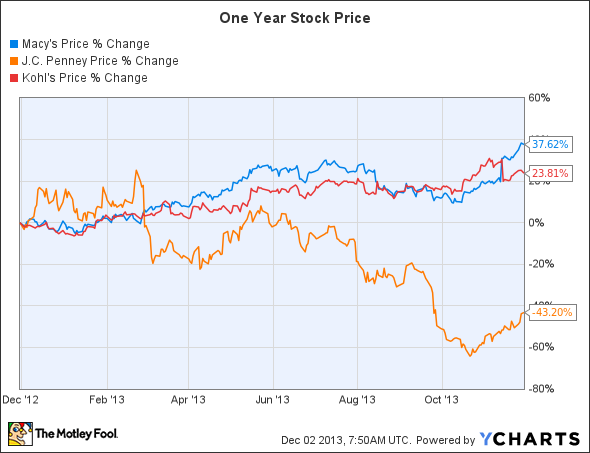Filed under: Investing
BofI Holding's stock price is up an astonishing 184% year to date and currently trading near four times book value -- a good sign the market is high on the company's potential and a great reason to take a closer look.

Recently, BofI conducted its first-quarter conference call, and today, I'll be digging into three of the most important things said by "America's oldest and most trusted Internet bank," CEO Greg Garrabrants.
"From December 2011 to September 2013, we grew our checking account balances by 554%, our money market balances by 140%."
Don't forget it wasn't that long ago we were looking at Amazon.com and wondering, "are people going to buy online?" Amazon was able to make the buying experience cheaper and easier, and this will be BofI's challenge.
So far, the company has been seen successful running promotions, including no overdraft fees and up to 1.25% APY -- which is six times the national average. The number of deposits has also been a beneficiary of the addition of Principal Bank back in June of 2013. Bank of Internet acquired approximately $173 million in deposits, along with 8,400 accounts -- 7,000 of which were checking accounts.
Just for comparison sake -- and keep in mind BofI still has a long way to go to catch either of these two banks in total deposits -- KeyCorp and Regions Financial have grown checking accounts by 23% and 25%, respectively, since 2011.
"The securitization market is still very tight, so those loans have to come through very clean."
Fannie Mae and Freddie Mac essentailly said, "Fool me once, shame on you; then we'll sue you and you won't fool us again." Okay, so maybe that's not exactly what was said, but you get the point. Regulations have been clamping down hard, and like CEO Garrabrants stated, loans have to be "very clean."
The banks that have been doing full documentation loans all along -- like Bank of Internet -- are going to have the fewest hiccups when it comes to coping with new regulations.
"We continue to make progress in growing and enhancing our deposits franchise. Our goal is to increase our share of transaction accounts, and develop deeper customer relationships."
This, to me, is the big one. We already touched on BofI's ability to grow deposits, but it's the second half of this quote that's most important. The real question is, how will the company develop customer relationships? What will the average Bank of the Internet customer say when his buddies ask him about how he likes the new bank?
KeyCorp and Regions Financial -- along with every other brick-and-mortar bank -- have an immediate advantage over BofI. There is a sense of security, call me old fashioned if you must, with having a bank that's a physical entity. This will be BofI's greatest obstacle standing between it becoming a run-of-the-mill bank or a banking juggernaut.
How does the future look?
For the time being, things look really bright for BofI. The company has a CEO with a lot of integrity, whose chief concern is going about business the right way -- the importance of which can't be overstated. Everything that's supposed to grow is growing, and everything that is supposed to be low is low.
Investors interested in BofI need to keep an eye on the company's ability to develop customer relationships and offer a product at a better price point. If it can do both, we may very well be looking at the next banking giant.
Is BofI the long-term winner in the shift to online banking?
The golden age of banking is dead. But if you want to learn how to take advantage of the impending bank renaissance, click below to discover the one company leading the way. You see, this fast-growing company is poised to disrupt big banking's centuries-old practices. And it stands to make early investors like YOU a fortune... if you act now. Our brand-new investor alert, "Big Banking's Little $20.8 Trillion Secret," lays bare every banker's darkest secret for the world to see. Simply click HERE for instant access!
The article 3 Things BofI Holding's CEO Just Said originally appeared on Fool.com.
Dave Koppenheffer has no position in any stocks mentioned. The Motley Fool recommends Amazon.com and BofI Holding. The Motley Fool owns shares of Amazon.com, BofI Holding, and KeyCorp. Try any of our Foolish newsletter services free for 30 days. We Fools may not all hold the same opinions, but we all believe that considering a diverse range of insights makes us better investors. The Motley Fool has a disclosure policy.Copyright © 1995 - 2013 The Motley Fool, LLC. All rights reserved. The Motley Fool has a disclosure policy.
Read | Permalink | Email this | Linking Blogs | Comments






 More strong news is out on the jobs front. The U.S. Labor Department reported that weekly jobless claims fell down to 298,000 in the latest week. Dow Jones was calling for about 320,000 and Bloomberg was calling for roughly 322,000 in this report.
More strong news is out on the jobs front. The U.S. Labor Department reported that weekly jobless claims fell down to 298,000 in the latest week. Dow Jones was calling for about 320,000 and Bloomberg was calling for roughly 322,000 in this report.











